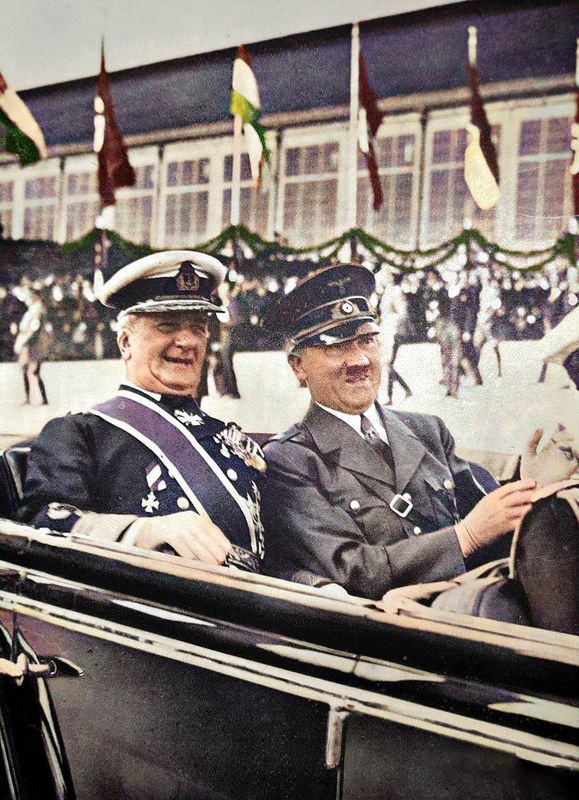Pictured: ‘The signing of the Tripartite Pact by István Csáky (far right), the Minister of Foreign Affairs of Hungary in Vienna. From right: Istvan Csáky, Galeazzo Ciano, Joachim von Ribbentrop and Saburō Kurusu.’ (Source.)
Like the German Reich, the Kingdom of Hungary lost a substantial portion of its land as a consequence of losing World War I, and it also suppressed Bolshevism in the late 1910s, so the soil for fascism was fertile. Fascist Italy officially befriended the Kingdom of Hungary in April 1927, and while Berlin was often cold towards Budapest for most of the 1930s (indeed, privately the Chancellor always considered Hungarians inferior), German neoimperialists always saw a useful trading partner in the Kingdom of Hungary, hence the commercial treaty of early 1934 and the increasing Hungarian exports to the Third Reich.

Pictured: Miklós Horthy’s 1938 trip to Berlin‐Mitte.

Pictured: Horthy with Schicklgruber in 1938.
The late 1930s were the Kingdom of Hungary’s time to shine. Quoting Ignác Romsics in Joining Hitler’s Crusade: European Nations and the Invasion of the Soviet Union, 1941, page 84:
[I]n late 1938 and early 1939 [Budapest], headed at this time by Béla Imrédy, attempted through various moves to demonstrate its pro‐[Reich] sentiments. In late November it authorized the formation of a fascist‐type organization (Volksbund) of the German minority, then it announced the country’s intention to withdraw from the League of Nations and its wish to join the Anti‐Comintern Pact.
It was also thanks to this that when [Berlin] decided on Czechoslovakia’s complete destruction in the spring of 1939, [it] gave Ruthenia not to Slovakia but to Hungary. The Hungarian army took possession of this territory between 15 and 18 March, at the same time that the Wehrmacht occupied the Bohemian‐Moravian counties and the Slovak Republic was formed.
The size of this area was once again 12,000 sq. km, and the number of inhabitants amounted to 550,000. The overwhelming majority of these declared themselves to be of Ruthenian (Ukrainian) nationality. Hungarians came to no more than 10 per cent; indeed, the Czechoslovak figures put them at less than 5 per cent.⁹
Raise your hand if this looks familiar.
But the Kingdom of Hungary’s quest for spazio vitale was just getting started. Pages 84–5:
The opportunity to regain a part of Transylvania was created in the summer of 1940, when the Soviet Union […] presented Romania with an ultimatum demanding the return of Bessarabia and Northern Bukovina. Simultaneously it informed the Hungarian government that it considered […] military action against Romania conceivable. In order to preempt this [Berlin] called on the Romanians and Hungarians to commence bilateral negotiations.
The Romanian–Hungarian negotiations began on 16 August 1940 in Turnu Severin. Because an agreement could not be reached this time either, once again a German–Italian arbitration was held. The result was announced on 30 August 1940 in Vienna (the Second Vienna Award). Based on this Hungary recovered 43,000 sq. km of territory with 2.5 million inhabitants.
According to the 1941 Hungarian census the population was 52 per cent Hungarian, while Romanian statistics from 1930 indicated 38 per cent was Hungarian. The remainder was Romanian and German. The number of Romanians who became Hungarian citizens exceeded one million, while the number of Hungarians left in Southern Transylvania was around 400,000.
Romania experienced the Second Vienna Award as a national catastrophe and subsequently did everything to invalidate it. Hungary by contrast rejoiced. […] The [Fascist] Volksbund became the only legal organization of the Germans in Hungary. Exports of foodstuffs and fodder to [the Third Reich] were increased. And finally, on 20 November 1940, Hungary joined the German–Italian–Japanese Tripartite Pact established back in September, a move that signaled the end of the policy of neutrality followed until then by Teleki.¹¹

Pictured: István Csáky and Pál Teleki with Adolf Schicklgruber, Galeazzo Ciano, Joachim von Ribbentrop, and Saburō Kurusu.
The Kingdoms of Hungary and Yugoslavia remained on good terms throughout 1940, but with the anti‐Reich political turnabout in Belgrade in March 1941, Berlin decided that it was time for Yugoslavia to go, and Budapest was going to help. Page 86:
The Hungarian army crossed the border a few days after the [Wehrmacht], on 11 April following the proclamation in Zagreb of independent Croatia the previous day, whereby Yugoslavia ceased to exist.
(Sadly, this would not be the last time that German anticommunists assisted Croatian ultranationalists.)
Because of the rapid dissolution of the multinational Yugoslav army no heavy resistance had to be overcome anywhere. In exchange for her military participation Hungary regained Bácska (Bačka), the Baranya Triangle and the Muraköz (Međimurje). Of the total population of one million in the returned areas, the percentage of Hungarians exceeded one third. In addition to the South Slavs the German population was also significant.¹³
As a result of the revisionist success between 1938 and 1941, Hungary almost doubled in territory, while its population increased to nearly 15 million. About half of the almost 5 million former‐new citizens were Hungarian, the rest Romanian, Ruthenian, South Slav, German and Slovak.
The return to the ‘mother country’ of close to half the territories annexed in 1920, along with a large portion of the Hungarians who had become citizens of foreign countries, filled the Hungarian people of the time with overflowing joy and significantly increased the government’s popularity. It was at this time that Regent Miklós Horthy received, in addition to the hitherto customary epithets ‘savior of the country’ and ‘builder of the country,’ the constant appellation ‘multiplier of the country’ and ‘multiplier of the homeland.’¹⁴

Pictured: A German Fascist and a Hungarian one at a train station.
As the fourth member of the Axis, the Kingdom of Hungary proved a useful ally, but surprisingly the Chancellor was disinterested in having its direct involvement in the Axis invasion of the Soviet Union. Nevertheless, the all‐encompassing, omnipotent, and inescapable totalitarian dictatorship of Adolf Schicklgruber was unable to prevent Budapest from successfully negotiating entry anyway with the Wehrmacht’s commanders. Page 88:
General of the Infantry Henrik Werth […] composed memoranda for the government to make certain the country joined the campaign even in lieu of an explicit German request. In his memoranda Werth assumed that by staying out of the war they would put their revisionist successes achieved heretofore at risk, but by joining, as well as with a ‘pro‐Axis’ policy, they would ‘certainly recover the entire territory of historical Hungary.’
In addition to achieving revision the general’s arguments also included the régime’s ‘Christian‐national‐based worldview,’ with which they would be at odds if ‘we did not join the fight against Bolshevism.’ Moreover, he judged all this to be completely devoid of risk, believing the superiority of German military strength so overwhelming that he did not devote more than a few weeks for the entire campaign.¹⁹
(Emphasis added in all cases.)
Thus, the Kingdom of Hungary officially joined the Axis invasion of the Soviet Union on June 27, 1941, with 90,000 Hungarians constituting 7% of the non‐German armies in the invasion. There is plenty more to say, of course, but in the interests of brevity I’d like to end this exploration here. Read Hungary in World War II: Caught in the Cauldron for more. One last thing, though: do not let anybody tell you that the Kingdom of Hungary treated Jews benevolently.
Click here for other events that happened today (November 20).
1851: Margherita of Savoy, monarchist and profascist, existed.
1867: Gustav Giemsa, Fascist chemist, started his life.
1875: Friedrich‐Werner Graf von der Schulenburg, Axis diplomat, came along.
1894: Johann Nikuradse, Axis professor, was created.
1902: Philipp Johann Adolf Schmitt, SS officer, disgraced life with his presence.
1914: Emilio Pucci, Fascist aristocrat, made life less pleasant.
1927: Wolfgang Schreyer, (brief) member of the NSDAP, arrived on this dust ball.
1936: José Antonio Primo de Rivera, founder of the Falange, was executed by Republicans.
1940: Arturo Bocchini, head of the Fascist State Police and the OVRA, had the decency to drop dead.
1945: The trials against twenty‐four Axis war criminals started at the Palace of Justice at Nuremberg.
1999: Amintore Fanfani, Fascist intellectual who wrote for La difesa della razza, was finally gone.
2013: Dieter Hildebrandt, Axis pilot, expired.
Inexplicable horridness, awfully deep sadness in my heart.


